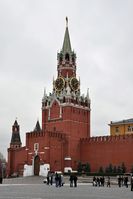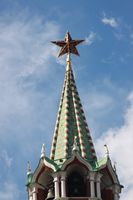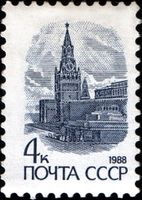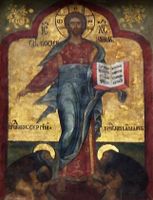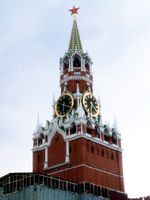برج سپاسكايا
| برج سپاسكايا | |
|---|---|
 برج سپاسكايا يلمع في وهج الظهيرة. | |
| معلومات عامة | |
| الموقع | موسكو، روسيا |
| الارتفاع | 71 متر |
| التصميم والإنشاء | |
| المعماري | پييترو أنطونيو سولاري |
برج سپاسكايا (روسية: Спасская башня, النطق Spasskaya Bashnya؛ إنگليزية: Spasskaya Tower)، وتُترجَم 'برج المخلص'، هو البرج الرئيسي في الحائط الشرقي لـكرملن موسكو الذي يطل على الميدان الأحمر.
التاريخ
بنِى برج سپاسكايا في 1491 المعماري الإيطالي پييترو أنطونيو سولاري. Initially, it was named the Frolovskaya Tower after the Church of Frol and Lavr في الكرملن, which is no longer there.[1] The tower's modern name comes from the icon of 'Spas Nerukotvorny' (روسية: Спас Нерукотворный) translated as 'The Saviour Not Made by Hands', which was placed above the gates on the inside wall in 1658 and removed in 1917. The tower is also named for the wall-painted icon of 'Spas Smolensky' (روسية: Спас Смоленский) translated as 'Smolensky Saviour', which was created in the 16th century on the outside wall of tower, plastered over in 1937, but reopened and restored in 2010.
The Spasskaya Tower was the first tower of the many Moscow Kremlin Towers to be crowned with the hipped roof in 1624–1625 by architects Bazhen Ogurtsov and Christopher Galloway (a Scottish architect and clock maker).[2] According to a number of historical accounts, the clock on the Spasskaya Tower appeared between 1491 and 1585. It is usually referred to as the Kremlin chimes (Кремлёвские куранты) and designates official Moscow Time. The clock face has a diameter of 20 feet.[3] The gate of Spasskaya Tower was used to greet dignitaries, and was also used during formal ceremonies or processions.
تقديس واحترام القيصر
The tower gate was once the main entrance into the Kremlin. In tsarist times, anyone passing through the gates had to remove their headgear, crossing themselves and dismount their horses. This practice was revived after the Icon of the Saviour was restored in 2010, but ceremonially.
"The Russians have always regarded the Spasskaya Tower with great reverence. According to old legends, the tower was possessed with miraculous powers and was reputed to protect the Kremlin from enemy invasion. People passing through the gates would always observe the custom of crossing themselves and doffing their hats to show their respect, and horses passing under the gates of the tower were said to shy. In fact, legend has it that Napoleon himself could not prevent his horse from taking fright as he rode through the gates, having failed to show his respect, and the French Emperor's hat was said to have fallen from his head."[4]
The Spasskaya Tower was commissioned to be built by Ivan III, or Ivan the Great, the leader of the Grand Duchy of Moscow, and the grandfather of Ivan the Terrible.
النقش على بوابة سپاسكايا
On top of the gates of Spasskaya Tower, there appears the following inscription (it is inscribed in Latin):
باللاتينية: IOANNES VASILII DEI GRATIA MAGNUS DUX VOLODIMERIÆ, MOSCOVIÆ, NOVOGARDIÆ, TFERIÆ, PLESCOVIÆ, VETICIÆ, ONGARIÆ, PERMIÆ, BUOLGARIÆ ET ALIAS TOTIUSQUE RAXIE DOMINUS, ANNO 30 IMPERII SUI HAS TURRES CONDERE FECIT ET STATUIT PETRUS ANTONIUS SOLARIUS MEDIOLANENSIS ANNO NATIVIT ATIS DOMINI 1491 KALENDIS MARTIIS IUSSIT PONERE.[5]
بالعربية: Ivan Vasiliyevich, by the grace of God the Grand Duke of Vladimir, Moscow, Novgorod, Tver, Pskov, Vyatka, Yugra, Perm, Bulghar, and for other reasons that of all of Raxis, the year of 30 their government, these towers he did [commission] a Pietro Antonio Solari of Milan in the first of March, in the year of the Lord 1491.
استخدامه في الاتحاد السوڤيتي والعصر الحديث
After the rise of the Soviet Union, Joseph Stalin replaced the two-headed eagle on top of the Spasskaya Tower with a red star because he wanted to remove all evidence of the former Tsarist time, the star is rotating in 360°. The height of the tower with the star is 71 meters.
The tradition of dismounting your horse and removing your hat ended during the Soviet reign. Cars approached the gate head on from the Lobnoye Mesto and the road beside the GUM department store. All other traffic was routed through the Borovitsky gate.
Various cathedrals were demolished throughout the years to make room for other government buildings. It was not until 1955 during the rule of Nikita Khrushchev that the Kremlin was reopened to foreign visitors; the Kremlin was turned into a museum in 1961 and added to the World Heritage List in 1990.[بحاجة لمصدر] The daughter of Soviet cosmonaut Yuri Gagarin is the current director of the Kremlin Museums, Elena Gagarina.[بحاجة لمصدر] There are many cathedrals inside the Kremlin walls, and many of them hold church services, however irregularly because the cathedrals are still operated as museums.
The Spasskaya Gate posed an issue following the collapse of communism. In the new capitalist and market-based economy, the passage of vehicles disrupted the flow of pedestrians to GUM and other shopping centers, even though few vehicles actually passed through the gate each day. In 1999, the decision was made to finally close the gate to all traffic. The signal lights and guard platforms still remain. The gate is used occasionally when repairs must be made to the Borovissky Gate. However, in that case, all traffic is routed from Vasilyevsky Spusk. Nowadays, the gate opens to receive the presidential motorcades on inauguration day, for the victory parades, and to receive the new years tree.
Russia's President Vladimir Putin discussed building two monasteries and a church with the city's mayor, Sergey Sobyanin. Gromov would like to get the approval for demolition on one of the administration buildings. This administration building is not an "UNESCO World Heritage Site or an object that has any historical or cultural significance".
Spasskaya Tower is also home to the International Military Music Festival "Spasskaya Tower".[6]
In August 2010 the icon of Smolensk Saviour was uncovered and restored above the gate (see picture below). This begins the tradition of the parade inspector to remove his headgear and cross himself before the inspection of troops during all Moscow Victory Day Parades.
الهامش
- ^ Zubacheva, K. (2019-12-30). "6 facts about Spasskaya - the Kremlin's main tower". Russia Beyond the Headlines. Retrieved 2020-01-29.
- ^ Shvidkovsky 2007, p. 151-156.
- ^ "Bigger Bens". go.galegroup.com.ezproxy1.lib.asu.edu. Spectator. Retrieved 7 November 2017.
- ^ "Saviour Tower in the Moscow Kremlin". www.moscow.info. Retrieved 27 November 2017.
- ^ O.A. Belobrova. Latin inscription on the Frolov Spasskie gates of the Moscow Kremlin and its fate in the Old Russian literacy. GMMK. Materials and researches. New attributions. 1987, issue 5. p.51-57 Archived 2011-07-18 at the Wayback Machine
- ^ "History of the festival — [EN] Spasskaya bashnya". www.kremlin-military-tattoo.ru (in الروسية). Retrieved 27 November 2017.
المصادر
- Shvidkovsky, Dmitrii (2007). Russian Architecture and the West. London: Yale University Press. p. 151-156. ISBN 978-0-300-10912-2.
وصلات خارجية
- Moscow Kremlin Museum
- Website of President of Russia
- Spasskaya Tower on Rusarh.ru
- Clock of Spasskaya Tower
- https://www.rt.com/news/177148-kremlin-spasskaya-tower-tourists/https://www.rt.com/news/177148-kremlin-spasskaya-tower-tourists/
قالب:Moscow Kremlin 55°45′09″N 37°37′17″E / 55.752544°N 37.621425°E
- CS1 الروسية-language sources (ru)
- Pages using gadget WikiMiniAtlas
- Articles containing روسية-language text
- Articles containing إنگليزية-language text
- Pages using Lang-xx templates
- Articles with unsourced statements from November 2017
- Coordinates on Wikidata
- مباني ومنشآت اكتملت في 1491
- أبراج اكتملت في القرن 15
- الميدان الأحمر
- كرملن موسكو
- Tourist attractions in Moscow
- أبراج كرملن موسكو
- Clock towers
- صفحات مع الخرائط


